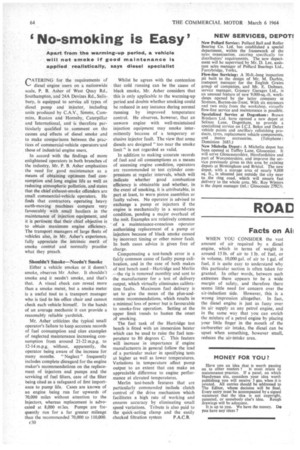No smoking is Easy'
Page 66

If you've noticed an error in this article please click here to report it so we can fix it.
Apart from the warming-up period, a vehicle will not smoke if good maintenance is applied realistically, says diesel specialist
rATERIING for the requirements of diesel engine users on a nationwide scale, P. B. Asher of West Quay Rd., Southampton, and 24A Devizes Rd., Salisbury, is equipped to service all types of diesel .pump and injector, including units produced by C.A.V., Simms, Cummins, Ruston and Hornsby, Caterpillar and• International, and is therefore particularly qualified to comment on the causes and effects of diesel smoke and to make comparisons between the plus:Ekes of commercial-vehicle operators and those of industrial engine users.
In accord with the findings of more enlightened operators in both branches of the industry, Mr. P. B. Asher emphasizes the need for good maintenance as a means of obtaining optimum fuel consumption and long engine life as well as reducing atmospheric pollution, and states that the chief exhaust-smoke offenders are small commercial-vehicle operators. He finds that contractors operating heavy earth-moving machines compare very favourably with small hauliers in the maintenance of injection equipment, and it is pertinent that their chief objective is to obtain maximum engine efficiency. The transport managers of large fleets of vehicles also, in Mr. Asher's experience, fully appreciate the intrinsic merit of smoke control and normally practise what they preach.
Shouldn't Smoke—Needn't Smoke
Either a vehicle smokes or it doesn't smoke, observes Mr. Asher. It shouldn't smoke and it needn't smoke, and that's that. A visual check can reveal more than a smoke meter, but a smoke meter is a useful tool to a transport manager who is tied to his office chair and cannot check each vehicle himself. In the hands of an average mechanic it can provide a reasonably reliable yardstick.
Mr. Asher criticizes the typical small operator's failure to keep accurate records of fuel consumption and cites examples of neglected maintenance increasing consumption from around 21-22 m.p.g. to 12-14 m.p.g. without, apparently, the operator being aware of the increase for many months. " Neglect" frequently includes complete disregard for the engine maker's recommendations on the replacement of injectors and pumps and the servicing of fuel filters, care of the filter being cited as a safeguard of first importance to pump life. Cases are known of an engine being run for upwards of 70,000 miles without attention to the injectors, whereas replacement is advocated at 8,000 mIles. Pumps are frequently run for a far greater mileage than the recommended 70,00(1 to 110,000.
c30 Whilst he agrees with the contention that cold running can be the cause of black smoke, Mr. Asher considers that this is only applicable to the warming-up period and doubts whether smoking could be reduced in any instance during normal running by improved temperature control. He observes, however, that an unworn engine with well-maintained injection equipment may smoke intermittently because of a temporary or elusive injector fault. The view that some diesels are designed "too near the smoke limit" is not regarded as valid.
In addition to making accurate records of fuel and oil consumptions as a means of assessing engine condition, operators are recommended to test cylinder compressions at regular intervals, which will indicate whether good combustion efficiency is obtainable and whether, in the event of smoking, it is attributable, in part at least, to worn piston asemblies or faulty valves. No operator is advised to exchange a pump or injectors if the engine is mechanically in a second-rate condition, pending a major overhaul of the unit. Examples are relatively common of a maintenance-conscious operator authorizing replacement of a pump or injectors because of black smoke caused by incorrect timing or other minor fault. In both cases advice is given free of charge.
Compensating a test-bench error is a fairly common cause of faulty pump calibration, and in the case of both makes of test bench used—Hartridge and Merlin —the rig is removed monthly and sent to the manufacturer for a test of delivery output, which virtually eliminates calibration faults. Maximum fuel delivery is set to give the mean of the plus-andminus recommendations, which results in a minimal loss of power but is favourable to smoke-free operation. Setting at the upper limit trends to hasten the onset of smoking.
The fuel tank of the Hartridge test bench is fitted with an immersion heater which can be used to raise the fuel temperature to 80 degrees C. This feature will increase in importance if engine manufacturers in general follow the lead of a particular maker in specifying tests at higher as well as lower temperatures. Variations in temperature affect pump output to an extent that can make an appreciable difference to engine performance at elevated temperatures.
Merlin test-bench features that are particularly commended include clutch control of the drive mechanism which facilitates a high rate of working and ensures accuracy by eliminating small speed variations. Tribute is also paid to the quick-acting clamp and the easily
checked filtration system P.A.C.B.




































































































































































